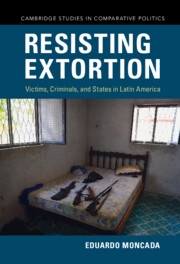Refine search
Actions for selected content:
44 results

The Making of Revolutionary Feminism in El Salvador
-
- Published online:
- 28 October 2025
- Print publication:
- 18 September 2025
Epilogue
-
- Book:
- Latin America and Human Rights Politics in West Germany, 1973–1990
- Published online:
- 18 October 2025
- Print publication:
- 18 September 2025, pp 305-322
-
- Chapter
- Export citation
Hidden in Plain Sight: The In/Visibility of Human Rights in El Salvador’s Prisons Under the State of Exception
-
- Journal:
- Latin American Research Review ,
- Published online by Cambridge University Press:
- 04 July 2025, pp. 1-19
-
- Article
-
- You have access
- Open access
- HTML
- Export citation
8 - El Salvador 1979
-
-
- Book:
- Coups d'État in Cold War Latin America, 1964–1982
- Published online:
- 24 April 2025
- Print publication:
- 08 May 2025, pp 177-196
-
- Chapter
- Export citation
Wild vertebrate roadkill in northern Central America: a first assessment using citizen science data
-
- Article
-
- You have access
- Open access
- HTML
- Export citation
3 - Transnational Approaches I
- from Part I - Setting the Stage: International and Transnational Law and Policies
-
- Book:
- Fighting Grand Corruption
- Published online:
- 03 April 2025
- Print publication:
- 10 April 2025, pp 42-57
-
- Chapter
- Export citation
Poverty and probability: aspiration and aversion to compound lotteries in El Salvador and India
-
- Journal:
- Experimental Economics / Volume 16 / Issue 3 / September 2013
- Published online by Cambridge University Press:
- 14 March 2025, pp. 263-284
-
- Article
- Export citation
Disasters in the Northern Triangle: A Descriptive Analysis Using the EM-DAT Database 1902-2022
-
- Journal:
- Prehospital and Disaster Medicine / Volume 38 / Issue 5 / October 2023
- Published online by Cambridge University Press:
- 27 September 2023, pp. 668-676
-
- Article
- Export citation
11 - The New Violence: Homicides, Drugs, and the State
- from Part III - Civil Rights as a Problem for Democracy
-
- Book:
- Latin American Politics and Society
- Published online:
- 11 June 2022
- Print publication:
- 09 June 2022, pp 386-428
-
- Chapter
- Export citation
6 - El Salvador’s Failed and Diffuse Security Taxes
-
- Book:
- Contemporary State Building
- Published online:
- 02 June 2022
- Print publication:
- 09 June 2022, pp 106-124
-
- Chapter
- Export citation
9 - Transitional Justice: Responses to Past Human Rights Violations
- from Part III - Civil Rights as a Problem for Democracy
-
- Book:
- Latin American Politics and Society
- Published online:
- 11 June 2022
- Print publication:
- 09 June 2022, pp 310-349
-
- Chapter
- Export citation
2 - Latin America’s Elite Security Taxes
-
- Book:
- Contemporary State Building
- Published online:
- 02 June 2022
- Print publication:
- 09 June 2022, pp 23-44
-
- Chapter
- Export citation
4 - Piecemeal Vigilantism
- from Part II - Everyday Resistance and Piecemeal Vigilantism
-
- Book:
- Resisting Extortion
- Published online:
- 23 December 2021
- Print publication:
- 06 January 2022, pp 92-118
-
- Chapter
- Export citation

Resisting Extortion
-
- Published online:
- 23 December 2021
- Print publication:
- 06 January 2022
7 - The Turn to Human Rights
- from Part IV - A People’s Compassion
-
- Book:
- The NGO Moment
- Published online:
- 01 October 2021
- Print publication:
- 14 October 2021, pp 137-155
-
- Chapter
- Export citation
7 - The Turn to Human Rights
- from Part IV: - A People’s Compassion
-
- Book:
- The NGO Moment
- Published online:
- 01 October 2021
- Print publication:
- 14 October 2021, pp 137-155
-
- Chapter
- Export citation
5 - Guatemala, 1989–1996
-
- Book:
- Incredible Commitments
- Published online:
- 02 October 2021
- Print publication:
- 23 September 2021, pp 131-163
-
- Chapter
- Export citation
Human responses to the Ilopango Tierra Blanca Joven eruption: excavations at San Andrés, El Salvador
-
- Article
-
- You have access
- Open access
- HTML
- Export citation
Promoting a ‘Pinochetazo’: The Chilean Dictatorship's Foreign Policy in El Salvador during the Carter Years, 1977–81
-
- Journal:
- Journal of Latin American Studies / Volume 52 / Issue 4 / November 2020
- Published online by Cambridge University Press:
- 05 October 2020, pp. 759-784
- Print publication:
- November 2020
-
- Article
-
- You have access
- HTML
- Export citation
9 - US State and Civil Society Responses to Salvadoran Refugees, 1980–1991
- from Part II - Refugee Movements during the Cold War and beyond
-
-
- Book:
- Refugee Crises, 1945-2000
- Published online:
- 13 October 2023
- Print publication:
- 01 October 2020, pp 209-234
-
- Chapter
- Export citation
